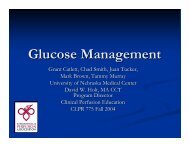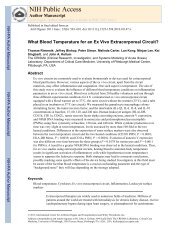Simulation - Perfusion.com
Simulation - Perfusion.com
Simulation - Perfusion.com
Create successful ePaper yourself
Turn your PDF publications into a flip-book with our unique Google optimized e-Paper software.
Using <strong>Simulation</strong> to<br />
Reduce Risk in<br />
<strong>Perfusion</strong><br />
Jeffrey B. Riley MHPE CCT CCP<br />
Mayo Clinic<br />
Rochester MN, USA 55902<br />
Reducing perfusion risk with simulation
Disclosure<br />
Mayo Clinic Division of Cardiovascular Surgery<br />
Research funding within the past year:<br />
Atricure<br />
Jarvik Heart<br />
Boehringer Ingelheim<br />
St. Jude Medical<br />
Bolton Medical<br />
Thoratec Corporation<br />
Carbomedics/Sorin Group<br />
Ventracor<br />
Edwards Lifesciences<br />
W.L. Gore and Associates<br />
Medtronic<br />
Current Technology Licensing Agreements:<br />
St. Jude Medical<br />
Sorin Group<br />
No personal equity, patents, licensing, or consulting agreements<br />
with the medical device or pharmaceutical industry to disclose<br />
Reducing perfusion risk with simulation
Rochester MN<br />
Reducing perfusion risk with simulation
<strong>Perfusion</strong><br />
<strong>Simulation</strong><br />
at the<br />
Mayo Clinic<br />
Multidisciplinary<br />
<strong>Simulation</strong> Center<br />
Reducing perfusion risk with simulation
The Mayo Clinic<br />
Cardiac surgery facts of interest<br />
t<br />
• 2 nd US News & World Report<br />
• 2,400+ annual cardiac surgeries<br />
• 10 surgeons, 16 anesthesiologists, 16<br />
perfusionists, i and multiple l ATs, MTs, CRNAs<br />
and CSTs<br />
• 8-9 cardiac ORs, 8-16 procedures per day<br />
• Annually: 200 pediatric, 325 adult congenital,<br />
35 VADs, 34 ECMOs, DHCAs, multiple re-<br />
operation procedures<br />
Reducing perfusion risk with simulation
<strong>Perfusion</strong>ists<br />
Self-Select<br />
ICEBP / AmSECT<br />
<strong>Simulation</strong> Pilot Project<br />
New Orleans, June 2009<br />
Assign to<br />
Sim Room<br />
Brief<br />
Delegate<br />
Run the<br />
<strong>Simulation</strong><br />
Rate at<br />
Four Levels<br />
Goals:<br />
• Can we measure perfusionist safety with<br />
simulation models in a large group?<br />
• Can we identify opportunities for <strong>com</strong>munity<br />
practice improvement?<br />
• Is current perfusionist practice consistent<br />
with best evidence-based guidelines?<br />
Analyze the<br />
Results<br />
Report<br />
Results<br />
Reducing perfusion risk with simulation
Objectives: Reducing <strong>Perfusion</strong> Risk<br />
with <strong>Simulation</strong><br />
• Define the concept of risk<br />
• What is risk in perfusion?<br />
• What makes perfusion safe?<br />
• Quantifying risk in perfusion<br />
• <strong>Perfusion</strong> team risk reduction<br />
model<br />
Reducing perfusion risk with simulation
What is Risk?<br />
• “Risk is a concept that denotes the<br />
precise probability of specific<br />
eventualities.”<br />
• Risk is not necessarily associated with<br />
positive or negative out<strong>com</strong>es<br />
• One may refer to the risk or probability of<br />
a beneficial result<br />
Wikipedia<br />
Reducing perfusion risk with simulation
Premise for <strong>Perfusion</strong> Team<br />
Risk Reduction Model<br />
6σ<br />
DMAIC<br />
Incident<br />
Reporting<br />
Reduce<br />
Incidence<br />
SPC Run<br />
Charts<br />
Remediate<br />
<strong>Simulation</strong><br />
Reducing perfusion risk with simulation
Human Factors and the<br />
Cardiac Surgical Team<br />
• HF contribution to cardiac surgery is be<strong>com</strong>ing<br />
obvious<br />
• Given the scientific gains in cardiac surgery – the<br />
greatest t opportunity for future improvement lies in<br />
improving human performance<br />
• Implies the evaluation of clinicians and of<br />
equipment and the interaction between the two<br />
• A large part of the HF science involves improving<br />
aspects of teamwork to reduce errors<br />
Reducing perfusion risk with simulation
Safety Drills for Common<br />
Cardiopulmonary Bypass Incidents<br />
• Annual <strong>com</strong>petency<br />
check-offs<br />
• Safety drills and crew<br />
resource<br />
management for<br />
critical incidents<br />
• Incorporate learning<br />
from procedure<br />
incident-reporting<br />
system and FMEA<br />
• Multi-disciplinary<br />
<strong>com</strong>munication<br />
Reducing perfusion risk with simulation
Simulator Use in the UK<br />
British Airways:<br />
3,200 pilots<br />
14 high-fidelity simulators<br />
Adherence to standards<br />
NHS in England:<br />
34,00 consultants<br />
47,000 doctors in training<br />
Fewer than 20 high-fidelity simulators<br />
Carraccio C, Wolfsthal SD, Englander R, Ferentz K, Martin C. Shifting paradigms: From Flexner to<br />
<strong>com</strong>petencies. Acad Med 2002;77:361-7<br />
Reducing perfusion risk with simulation
Cardiothoracic Surgical <strong>Simulation</strong><br />
• Traditional apprenticeship model<br />
• Visioning <strong>Simulation</strong> Conference e was held in April 2007<br />
• <strong>Simulation</strong> will also bring any conflict between service<br />
and education to the forefront<br />
• Meeting patient care demands, already stressed by<br />
restricted work hours, will be further stressed by having<br />
residents partially educated with simulators.<br />
• Who will be the teachers in a simulation curriculum<br />
• Stimulate development of more simulators specific to<br />
cardiothoracic surgery<br />
• The use of simulators will revolutionize education in<br />
cardiothoracic surgery in the near future, but it will<br />
require creativity, hard work, leadership, and money.<br />
Feins RH. Expert <strong>com</strong>mentary: Cardiothoracic surgical simulation. JTCVS 2008;135:485-6.<br />
Reducing perfusion risk with simulation
Is <strong>Perfusion</strong> Ready for the “Flock of<br />
Geese?” [ICEBP 2009]<br />
• US Airway flight 1549 landed in in the Hudson River – all<br />
155 passengers and crew were safely extracted t with in<br />
minutes<br />
• Safety yp principles p are engrained early in perfusion<br />
education<br />
• Standardization of CPB is a key ingredient to safety – just<br />
like in the airline industry<br />
• Our colleagues have developed EB guidelines focused<br />
on CPB principles<br />
• Collect data is a starting point of benchmarking<br />
• Cannot always anticipate crisis events during CPB<br />
• This meeting is synergistic and unique opportunity<br />
ICEBP Committee. AmSECT Today: May/June:14<br />
Reducing perfusion risk with simulation
Are You a Safe <strong>Perfusion</strong>ist?<br />
• What is the risk of an undesired out<strong>com</strong>e while<br />
you are operating the heart lung machine ?<br />
• Safe perfusionists do more than conduct bypass<br />
safely<br />
• Safe perfusionists study their practice and<br />
evaluate the risk of adverse events (being free of<br />
adverse events)<br />
• What are your most frequent adverse perfusion<br />
events?<br />
• How many CPB procedures do you perform<br />
between adverse perfusion events?<br />
Reducing perfusion risk with simulation
<strong>Perfusion</strong> Event-Reporting<br />
• Event or variance-reporting reporting is important for<br />
sustaining i a safe perfusion practice.<br />
• Variance reporting identifies and logs our<br />
experiential learning.<br />
• Reviewing the perfusion case report literature<br />
identifies the evidence side of safe perfusion<br />
practice.<br />
• Clinician process improvement ideas should be<br />
captured daily as an integral element of safe<br />
perfusion practice.<br />
Reducing perfusion risk with simulation
Preparing to Use<br />
<strong>Simulation</strong><br />
• Task (or job) analysis is a science<br />
to itself<br />
• There are standards for designing<br />
and conducting simulations<br />
• Interviewing, flow-charting and<br />
root cause analyses are used to<br />
design effective simulations<br />
• <strong>Simulation</strong> briefing, and debriefing<br />
are employed to give clinicians<br />
opportunities to demonstrate their<br />
skills and knowledge in high<br />
fidelity situations<br />
Dunn W, Murphy JG. <strong>Simulation</strong>: About safety,<br />
not fantasy. Chest 2008;133:1719-20.<br />
C:\Documents and Settings\m051242\Desktop\simulation.abc<br />
Tuesday, March 24, 2009<br />
7:52 AM<br />
Begin<br />
<strong>Simulation</strong><br />
No<br />
AMOD-01:___<br />
Read Patient<br />
Medical<br />
Record<br />
Set-Up HLM<br />
and DMS<br />
Surgeon: "Aortic<br />
cannula is in"<br />
Perf Test<br />
Art Line?<br />
<strong>Perfusion</strong>ist Tests<br />
Art LIne, Discovers<br />
Clamp<br />
<strong>Perfusion</strong>ist Communicates<br />
Appropriately<br />
Surgeon: "Go on<br />
bypass'<br />
Anesthesiologist: "Let me know<br />
when you are up to full flow"<br />
Initiate<br />
CPB per<br />
MD VO<br />
No<br />
Orpheus: Clamp arterial line<br />
Orpheus: Unclamp arterial line<br />
AMOD-02:___<br />
On CPB: P2<br />
Orpheus: Set SVR = 7<br />
Reducing perfusion risk with simulation
<strong>Simulation</strong> Scenarios<br />
• Briefing<br />
• Scenario one<br />
• Debrief one<br />
• Scenario two<br />
• Debrief two<br />
• Evaluation<br />
• Meta-Evaluation<br />
Reducing perfusion risk with simulation
CRM – Seven Skills<br />
• Mission / Flight Analysis<br />
• Assertiveness<br />
• Decision Making<br />
• Communication<br />
• Leadership<br />
• Adaptability and Flexibility<br />
• Situational Awareness<br />
Reducing perfusion risk with simulation
Orpheus <strong>Perfusion</strong> Simulator<br />
Reducing perfusion risk with simulation
ECMO Specialist Case Study<br />
• ECMO case study<br />
• ECC arterial line<br />
hypertension during<br />
ECMO<br />
• Reduce negative<br />
patient risks<br />
associated with<br />
ECLS<br />
• Role of debriefing in<br />
simulation<br />
<strong>Simulation</strong> in Healthcare. 2006;1:220-7<br />
Reducing perfusion risk with simulation
Future <strong>Simulation</strong> Scenarios<br />
to Drive Out Risk<br />
• The most frequently identified reasons for<br />
incidents of patient harm resulting from technical<br />
errors with equipment are user error and<br />
inadequate device education<br />
• If surgical (multidisciplinary) teams use incident<br />
reporting and process improvement ideas, there<br />
are numerous future simulation scenarios<br />
• <strong>Simulation</strong> has been demonstrated to reduce the<br />
negative risks associated with ECC and ECLS<br />
• <strong>Simulation</strong> center activities must be a<br />
professional extension of the clinical perfusion<br />
Reducing perfusion risk with simulation
Thank you!<br />
Riley.Jeffrey@Mayo.edu<br />
Reducing perfusion risk with simulation
Reducing perfusion risk with simulation
Reducing perfusion risk with simulation
Comparison of Learning Constructs<br />
Tradition-based Programs<br />
Constructivist-Based Programs<br />
Teaching<br />
Teacher-centered centered instruction<br />
Authority driven<br />
Learning as product<br />
Knowledge is fixed<br />
Isolated work<br />
Information deliver<br />
Skill acquisition and rote learning<br />
Practice makes “correct”<br />
Learning<br />
Student-centered instruction<br />
Empowerment<br />
Learner autonomy and initiative<br />
Knowledge is provisional<br />
Collaborative work<br />
Knowledge creation and exchange<br />
Exploratory, inquiry-based learning<br />
Practice as “shifting<br />
Campbell MR, Brummett VM. Mentoring preservice teachers for development and growth of<br />
professional knowledge. Music Educators Journal, 2007;93(3):50-55.<br />
Reducing perfusion risk with simulation
















